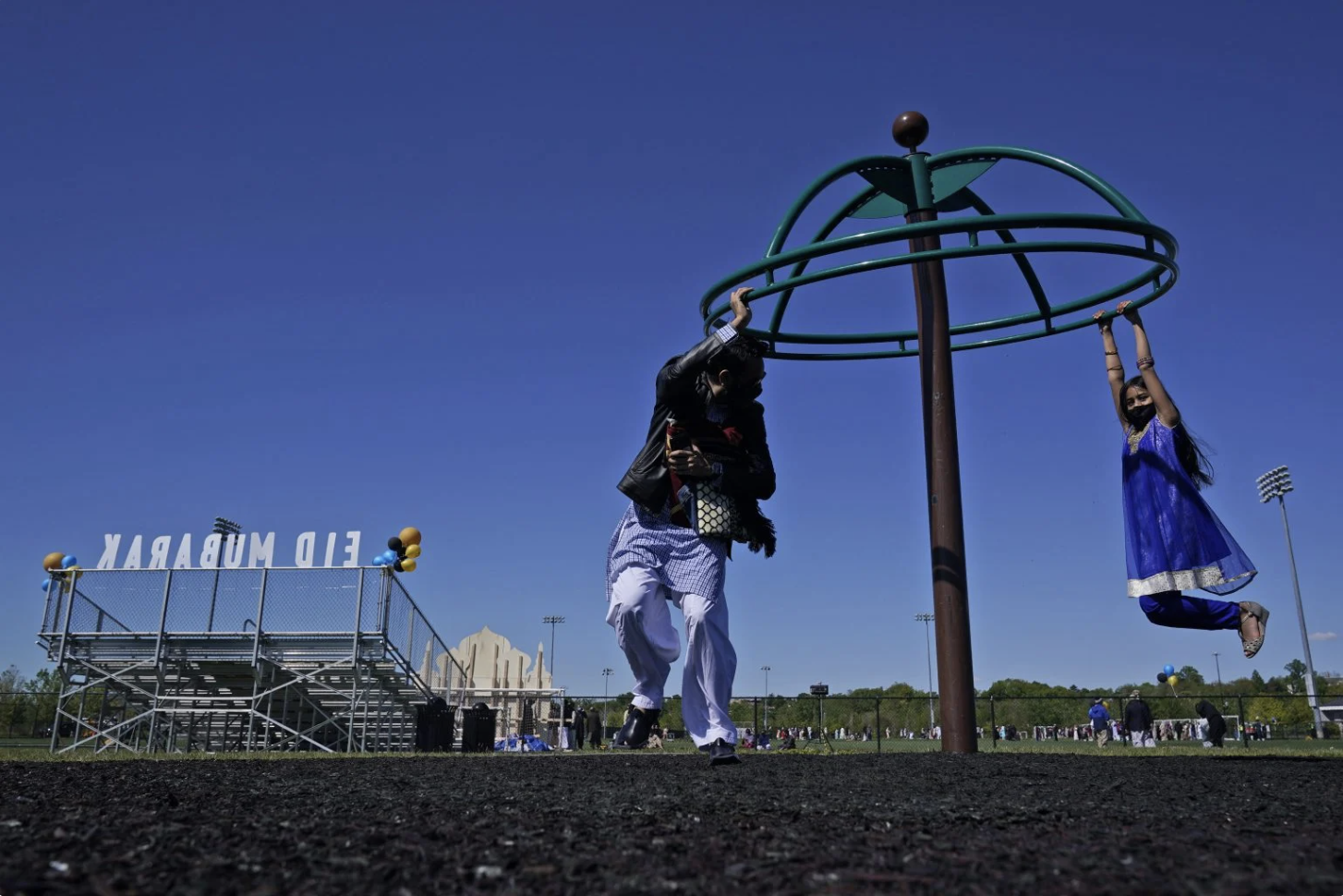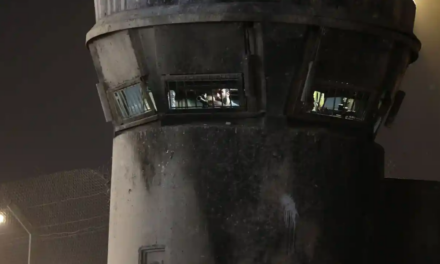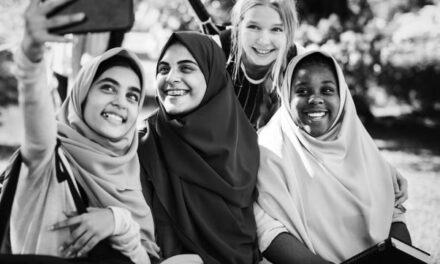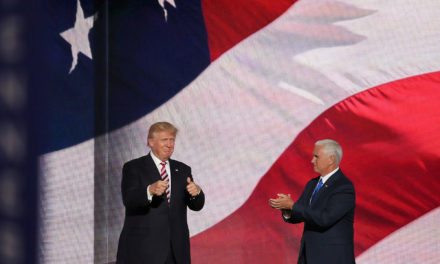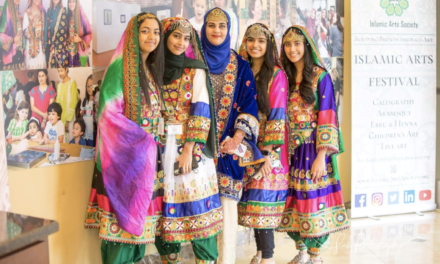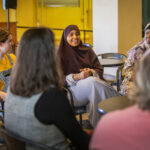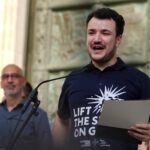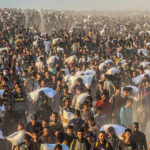Saif Chaudhry plays with his daughter Ariana Chaudhry, 8, on a playground near the site of an outdoor celebration of Eid al-Fitr in Overpeck County Park in Ridgefield Park, New Jersey, May 13, 2021, at the end of Ramadan. (AP Photo/Seth Wenig)
(RNS) — Scrolling Twitter on the first evening of Ramadan 2023, I was greeted (well, as all Muslims were) by Elmo. “Ramadan Mubarak to all of Elmo’s friends!” the red toddler Muppet said. “Elmo loves you!”
In Chicago, the marquee at famed Wrigley Field displayed a Ramadan Mubarak message for the second year in a row to Cubs fans and all Chicagoans.
Even Michaels — the craft and last-minute decoration store destination for all parents who are told by their kids in the nth hour that they need special markers or poster board or some craftsy thing — offered up Ramadan stickers to me yesterday when I rushed in for some Command Strips to finish hanging up our Ramadan decorations. (And yes, items for my youngest son’s last-minute school project.)
It’s no secret that businesses, educational institutions, workplaces, even Sesame Street celebrities have been acknowledging and sharing Ramadan greetings for several years now. We’ve gone from special Ramadan Mubarak (blessed Ramadan) and Ramadan Kareem (generous Ramadan) ads on television featuring hijab-wearing women to hijabi women appearing as just another person in the background of numerous marketing campaigns. (Nike’s Colin Kaepernick ad comes to mind.)
And I am joyfully here for it all.
A few years ago I completed my lunar cycle of fasting, the 33-year journey following the ever-shifting lunar calendar as it migrates through the solar-based Gregorian calendar. I fasted my first full 30 days of Ramadan as a 13-year-old seventh grader in her first (and only) season of track, when Ramadan occurred in May. Thirty-three years later (two years ago for me), Ramadan again fell in May, having shifted backwards in yearly 10-day increments over that span.
Then I was one of the only kids fasting in school (my older brother was the other one) in a Midwestern school community that didn’t really get what we were doing as Muslims but allowed us to hang out in the counselor’s office or library at lunchtime. By the time I completed the lunar fasting cycle, my ninth grader son was texting our family group chat a photo of the “Ramadan Mubarak” sign hanging in his school library.
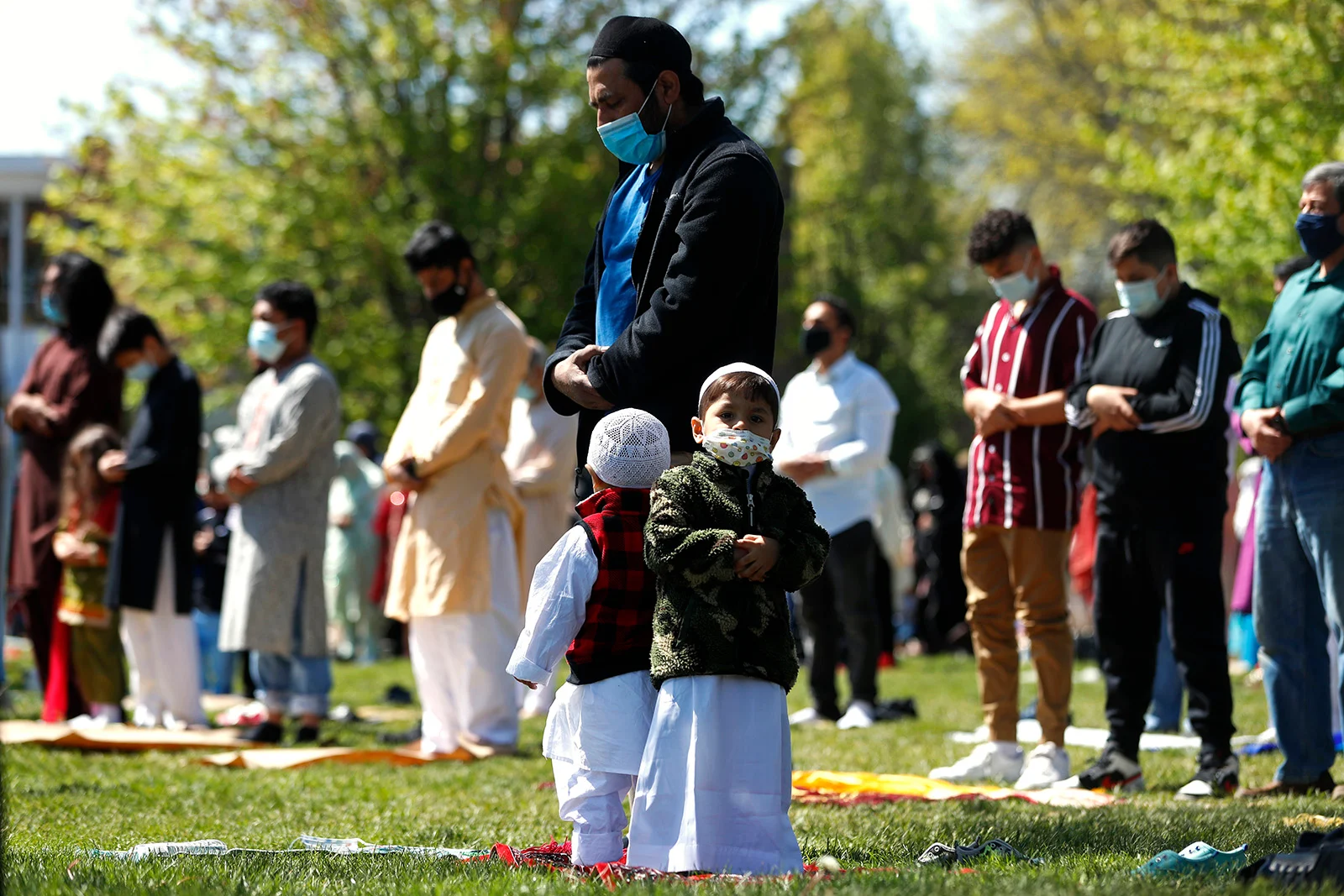
Two children stand with their father as he and other Muslims perform an Eid al-Fitr prayer in an outdoor open area, marking the end of the fasting month of Ramadan, May 13, 2021, in Morton Grove, Illinois. (AP Photo/Shafkat Anowar)
And, here’s the best part.
Last week at my son’s first ever school tennis match, one of the coaches approached me as I watched him play doubles and asked if I was his mom. When I replied yes, she asked me if he would be fasting for Ramadan.
“I’m trying to talk with the parents of all the kids who will be fasting on the boys’ and girls’ tennis teams,” she told me. “I want to know what their fasting plans will be so we can make sure to best accommodate them and keep an eye on them as they play — make sure they aren’t getting too tired or anything.”
I was floored. The coach approached me. I didn’t have to set up a meeting or send an email (as I always have) to talk through spring sports and the fasting month and how we could make it work. I also didn’t have to ask the PE teacher to go easy on my guy. (He already knew about Ramadan, and besides my son asked me to not say anything, that he could handle gym class. You know: Butt out, Mom.)
This shift is the result of so many American Muslim organizations taking on this fight over the years, so many grassroots efforts by parents and other American Muslims educating our communities around the country. We have built awareness about our faith and about humanity. It has been extremely hard-fought and messy, and, to be sure, it isn’t this way everywhere. There is always more growth to be had in our schools, workplaces and community structures. I’m not taking it for granted. But Ramadan is at last becoming baked into American life, and yeah, it feels good.
My aspiring tennis star is not the only one who is being recognized. In the United Kingdom, where Ramadan lights are up for the first time in Piccadilly Circus, officials in the Premier League, soccer’s major leagues, have been advised to allow for stoppage of play for Muslim players to break their fast at sunset.
I reached out to Ahmed Rehab, executive director of the Chicago chapter of the Council on American-Islamic Relations and avid soccer fan, to ask him about the magnitude of what this means. “For the longest time,” he explained, “Muslims watched certain levels of sport in the West as pure spectators, distant from the superheroes on the pitch. Over time … we began to be those superheroes on the pitch, on the fields and on the greatest sports platforms.
“As that happened, our values and our lifestyles became less foreign and less distant. It’s not that we need validation; it’s an assertion of who we are and what matters to us. For major sports to acknowledge us, it’s really amazing. It’s another milestone of belonging,” he said.
For me, it’s just as big as my son’s tennis coach approaching me to have a Ramadan discussion about how to balance sport and fasting. It wasn’t about my son not playing or about drastically changing team schedules to accommodate the Muslim kids. It was about how to best help him make all parts of his life work in harmony. When I excitedly related the conversation to my son after his match was over, he was nonplussed, as if that was to be expected.
Yes. Exactly.
By Dilshad D. Ali
(Dilshad D. Ali is a journalist and blog editor for the website Haute Hijab, an e-commerce company that works to serve Muslim women. The views expressed in this commentary do not necessarily reflect those of Religion News Service.)
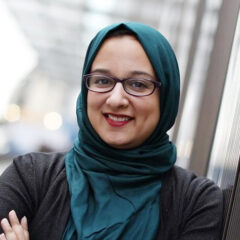
Dilshad D. Ali. Courtesy photo
